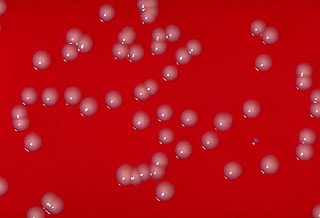Related Research Articles

The Chlamydiota are a bacterial phylum and class whose members are remarkably diverse, including pathogens of humans and animals, symbionts of ubiquitous protozoa, and marine sediment forms not yet well understood. All of the Chlamydiota that humans have known about for many decades are obligate intracellular bacteria; in 2020 many additional Chlamydiota were discovered in ocean-floor environments, and it is not yet known whether they all have hosts. Historically it was believed that all Chlamydiota had a peptidoglycan-free cell wall, but studies in the 2010s demonstrated a detectable presence of peptidoglycan, as well as other important proteins.

Corynebacterium is a genus of Gram-positive bacteria and most are aerobic. They are bacilli (rod-shaped), and in some phases of life they are, more specifically, club-shaped, which inspired the genus name.
Atopobium is a genus of Actinomycetota, in the family Coriobacteriaceae. Atopobium species are anaerobic, Gram-positive rod-shaped or elliptical bacteria found as single elements or in pairs or short chains.
Cupriavidus gilardii is a Gram-negative, aerobic, motile, oxidase-positive bacterium from the genus Cupriavidus and the family Burkholderiaceae. It is motil by a single polar flagellum. It is named after G. L. Gilardi, an American microbiologist. The organism was initially identified as Ralstonia gilardii in 1999, renamed Wautersiella gilardii, and most recently moved into the genus Cupriavidus after 16S rRNA gene sequencing revealed it to be most closely related to Cupriavidus necator. Notably, species of this genus are not inhibited by copper due to the production of chelation factors, and may actually be stimulated by the presence of copper.
Lactobacillus iners is a species in the genus Lactobacillus. It is a Gram-positive, catalase-negative, facultatively anaerobic rod-shaped bacterium. Lactobacillus iners is a normal inhabitant of the lower reproductive tract in healthy women.
Fannyhessea vaginae is a species of bacteria in the family Atopobiaceae. It is a facultative anaerobic, Gram-positive rod-shaped or elliptical coccobacillus found as single elements or in pairs or short chains. It is typically isolated from 80% of women with bacterial vaginosis and it is implicated in treatment failures. Invasive infections such as bacteremia have been reported.
Dialister pneumosintes is a nonfermentative, anaerobic, gram-negative rod that grows with small, circular, transparent, shiny, smooth colonies on blood agar. D. pneumosintes has been recovered from deep periodontal pockets, but little is known about the relationship between the organism and destructive periodontal disease.
Pseudoglutamicibacter cumminsii is a species of Gram-positive bacteria.
Gemella sanguinis is a species of bacteria within the genus Gemella. Strains of this species were originally isolated from samples of human blood, and in one case from a patient with endocarditis. Additional cases of endocarditis associated with G. sanguinis infections have been reported.
Gemella palaticanis is a species of bacteria within the genus Gemella. Strains of this species were originally isolated from the mouth of a dog and are unique among Gemella species in that they can ferment lactose.
Dysgonomonas is a Gram-negative and facultatively anaerobic genus from the family of Dysgonomonadaceae which have been isolated from human sources. Dysgonomonas bacteria can cause gastroenteritis in immunocompromised persons
Dolosicoccus is a Gram-positive, facultatively anaerobic and non-motile genus of bacteria from the family of Aerococcaceae with one known species.
Dolosicoccus paucivorans is a Gram-positive bacteria from the family of Dolosicoccus which has been isolated from human blood in the United States.
Facklamia ignava is a Gram-positive bacteria from the family of Facklamia which has been isolated from humans.
Facklamia languida is a Gram-positive bacteria from the family of Facklamia which has been isolated from humans.
Facklamia miroungae is a Gram-positive and facultatively anaerobic bacteria from the family of Facklamia which has been isolated from the nasal cavity of a southern elephant seal.
Facklamia sourekii is a Gram-positive and facultatively anaerobic bacteria from the family of Facklamia which has been isolated from humans.
Facklamia tabacinasalis is a Gram-positive bacteria from the family of Facklamia which has been isolated from powdered tobacco.
Ignavigranum is a Gram-positive, facultatively anaerobic non-spore-forming and non-motile genus of bacteria from the family of Aerococcaceae with one known species.
Ignavigranum ruoffiae is a Gram-positive and facultatively anaerobic bacteria from the family of Ignavigranum which has been isolated from a human wound in the United States.
References
- 1 2 3 4 5 6 7 8 9 Parte, A.C. "Facklamia". LPSN .
- ↑ "Facklamia". www.uniprot.org.
- ↑ Hoyles, Lesley (2014). "The genus Facklamia". Lactic Acid Bacteria. John Wiley & Sons, Ltd: 91–98. doi:10.1002/9781118655252.ch8. ISBN 9781118655252.
- ↑ Paul De Vos; et al., eds. (2009). Bergey's manual of systematic bacteriology (2nd ed.). Dordrecht: Springer. ISBN 978-0-387-68489-5.
- ↑ She, Rahmati (2017). "Facklamia Species as an Underrecognized Pathogen". Open Forum Infect Dis. 4 (1): ofw272. doi:10.1093/ofid/ofw272. PMC 5414014 . PMID 28480264.